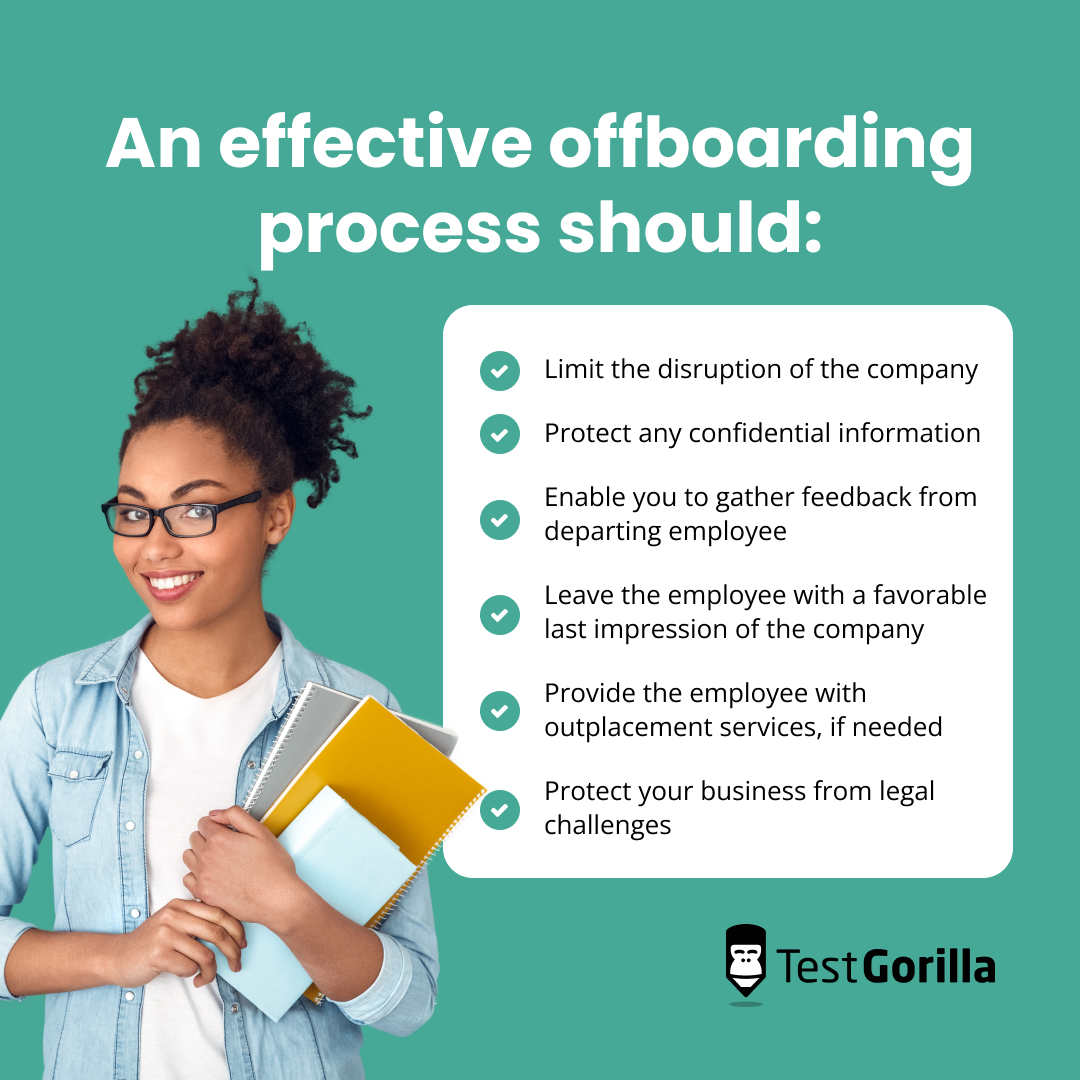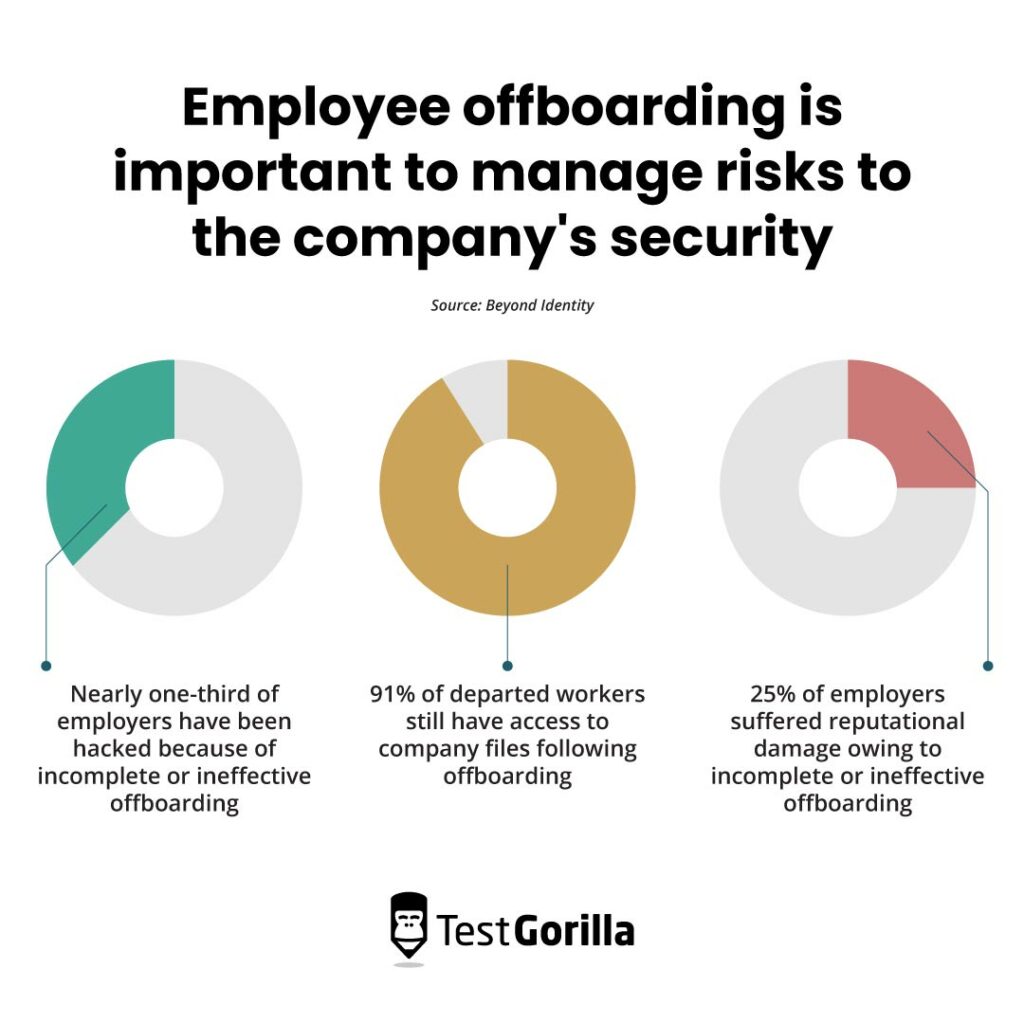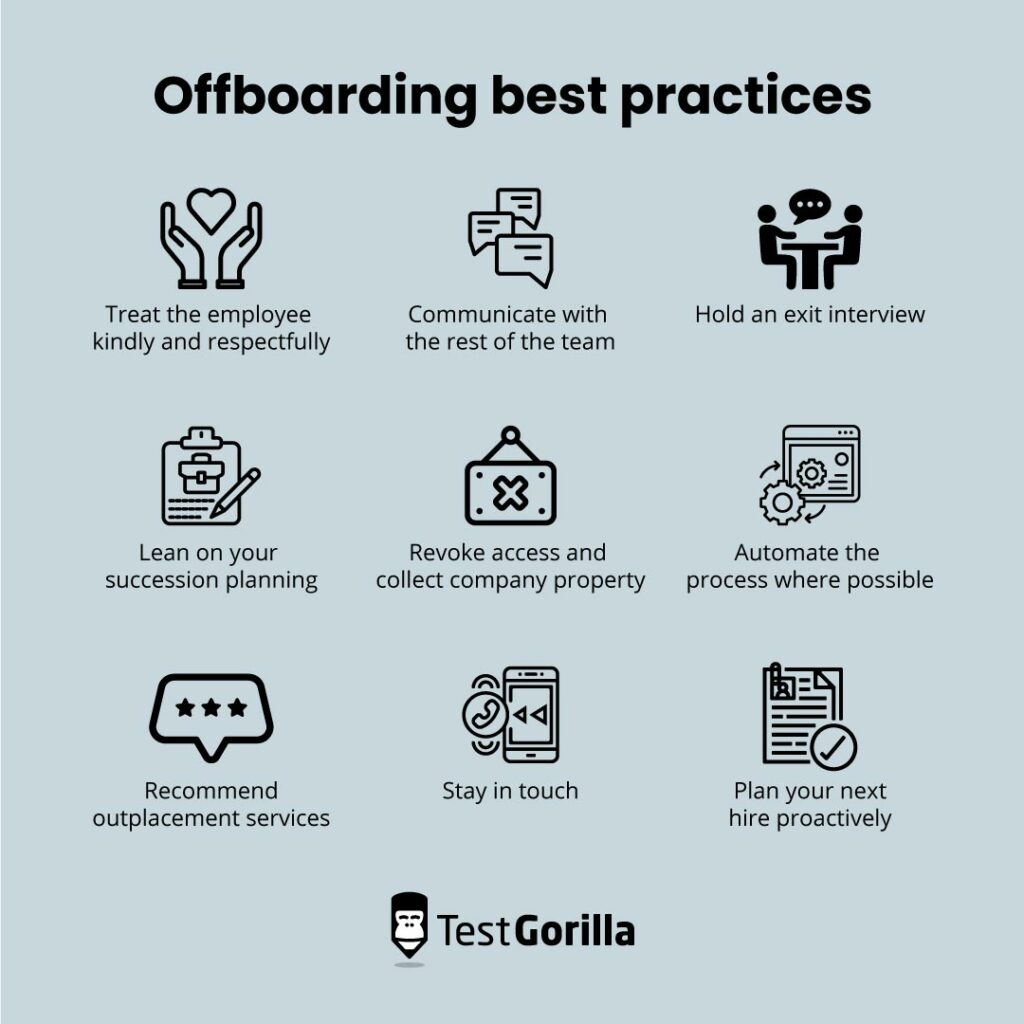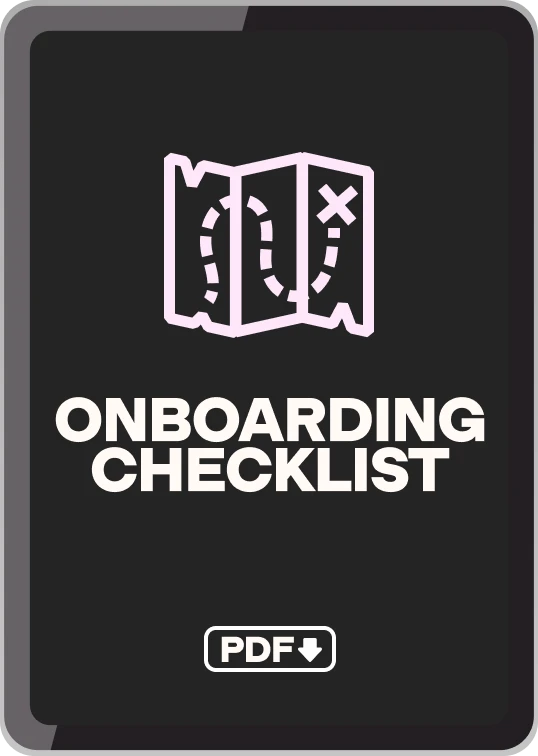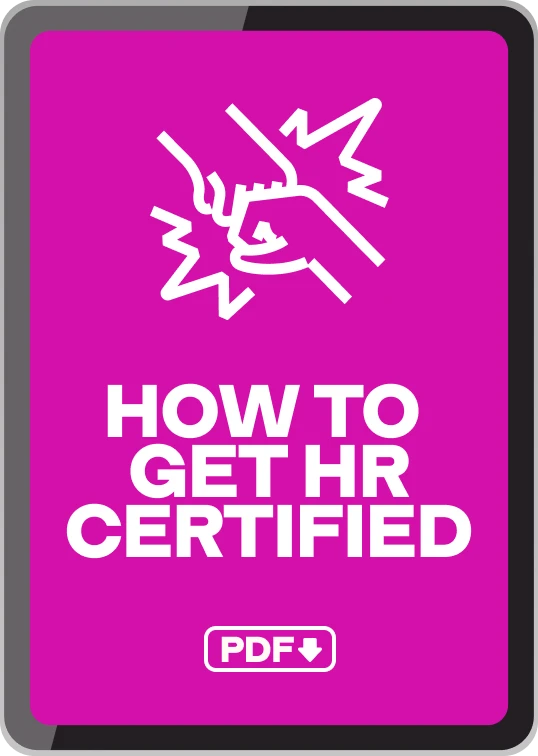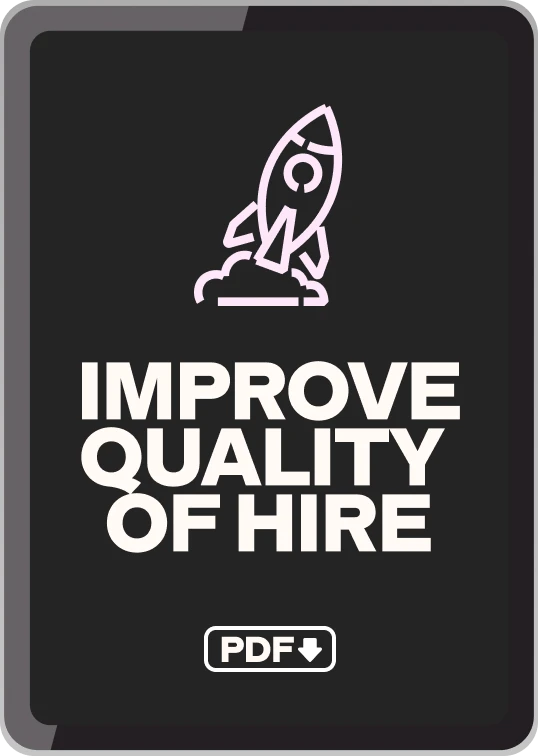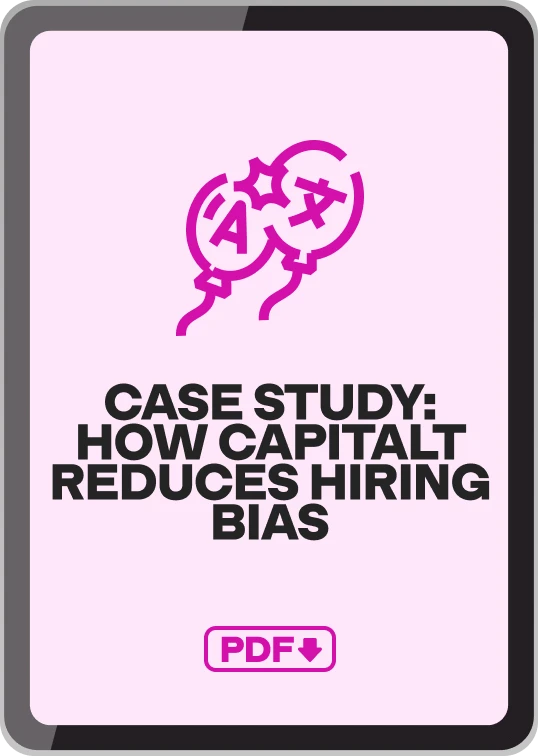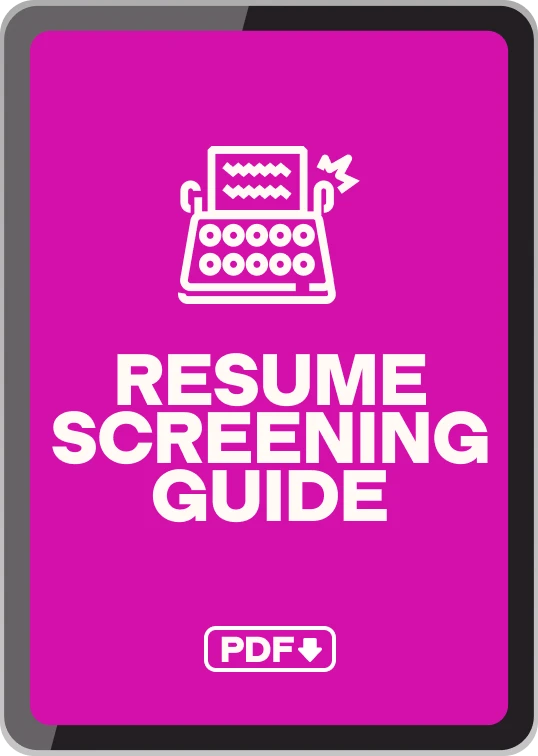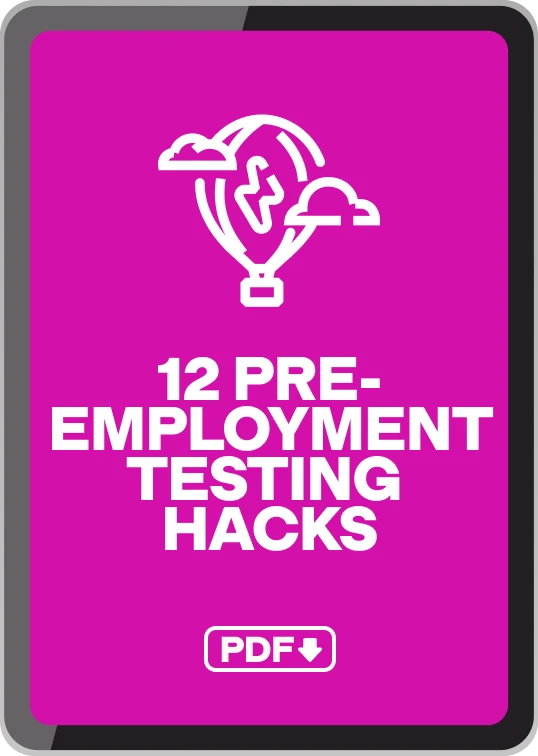Employee offboarding guide: Checklist and best practices
Making a good final impression on departing employees is more than just a matter of courtesy.
Employees who remember your organization poorly are less likely to return to you in the future – and more likely to speak negatively about your company to others, hurting your employer brand.
On the other hand, a successful offboarding experience enables you to maintain a strong relationship with departing employees.
A good employee offboarding process is especially important if you’ve put effort into hiring the right people, you must ensure that you stay on good terms after they leave.
Start by using our quick employee offboarding checklist below. Afterward, learn why a good offboarding process matters and the best practices for offboarding a departing employee.
Table of contents
- An example employee offboarding checklist
- What exactly is employee offboarding?
- How is the offboarding process different from an offboarding policy?
- Onboarding a departing employee: Why it matters
- Optimize your employee offboarding process with these 9 best practices
- Refine your employee offboarding process and reap its benefits
An example employee offboarding checklist
If you want to nail your offboarding process but need help figuring out where to start, get started with the template below.
It shows all the best practices we'll discuss in detail below, and you can keep track of deadlines and completion. You can even note down who is responsible for following through on each step.
Quick note: This checklist is a starting point, not a definitive list, so adjust it to reflect your organization's specific needs and ensure that your offboarding process ties up all loose ends.
Item | Due Date | Person Responsible | Date Completed |
1. Prepare legal paperwork for departure (including notice of resignation/termination and benefits documents) | |||
2. Set up a knowledge transfer between the departing employee and a colleague or team member | |||
3. Schedule an exit interview | |||
4. Recommend outplacement services, if applicable (usually applicable for laid-off employees) | |||
5. Announce the departure to the rest of the company | |||
6. Organize a farewell gathering and/or buy a gift | |||
7. Invite the employee to join an alumni program, if applicable | |||
8. Issue the employee’s final paycheck | |||
9. Calculate and pay out any unclaimed benefits before the employee’s last day | |||
10. Issue the employee’s severance package, if applicable | |||
11. Terminate all IT accounts and disable all access to company data | |||
12. Reclaim all business property and assets | |||
13. Terminate all building access | |||
14. Collect ID | |||
15. Thank the employee for their work |
Now, let's take a closer look at a typical organization's employee offboarding process and how you can improve yours.
What exactly is employee offboarding?
Offboarding is the process of transitioning an employee out of your company.
It happens when an employee resigns, retires, or is fired.
The goal of offboarding is to end the relationship between employer and employee on a positive note, leaving scope for reconnection in the future.
That’s especially true if an employee has been fired or laid off. They could have complex feelings about leaving your business, and it’s important to approach their departure carefully.
An effective offboarding process should:
Limit disruption to the company and existing employees
Protect any confidential information
Enable you to gather employee feedback from the departing employee
Leave the employee with a favorable last impression of the company
Provide the employee with outplacement services, if needed
Protect your business from legal challenges or financial management issues after the employee’s departure, including wrongful pay continuation
How is the offboarding process different from an offboarding policy?
An offboarding policy is a plan that guides your company’s offboarding process.
If offboarding involves guiding employees out of your company, your offboarding policy should act as the map that helps you send them on their way.
You must have that map because it creates a consistent experience for all your employees. Without it, HR staff could miss important steps in the process or treat some departing workers less respectfully than others.
A formal policy codifies every step of the offboarding process, leaving no room for unconscious bias or omission.
A good offboarding policy should contain:
Templates for all the legal paperwork you need for finalizing an employee’s departure
Templates for departure announcements, offboarding emails, and other communications relevant to a leaving employee
Financial procedures, including guidance on final payouts, severance packages, and benefits
Guidance to support knowledge transfers between departing employees and their colleagues
Procedures for the return of all company assets and property
Procedures for the closure of IT accounts and the revocation of access to information
A template for exit interviews
Onboarding a departing employee: Why it matters
Getting offboarding right has positive effects on your company and your staff.
With a solid offboarding policy for exiting employees to guide you, you can implement a process that leaves all parties in a good place.
Even if you have to fire an employee, offboarding can be a way to manage the stresses of the situation for everyone.
1. Close the door on your employee’s time with you
Some of your departing employees may have been long-term workers. Most of them will have made valuable contributions to your business and its culture.
Offboarding is a way to make sure that their time and investment don’t go unrecognized. Think of this process as the capstone of a departing employee’s experience in your company. It’s your last chance to show them that you value them for the work they’ve done for you and the energy they’ve given to your organization.
It’s also an opportunity for their colleagues to say goodbye. Offboarding employees sensitively and respectfully also gives your remaining staff a way to adjust to the change in the workplace.
When your remaining employees see you treating their colleagues well even after they’ve decided to leave, they’ll feel better about where they’ve chosen to work. This practice helps you maintain a positive company culture.
2. Manage risks to the company’s security
The cybersecurity firm Beyond Identity found that:
Nearly one-third of employers have been hacked because of incomplete or ineffective offboarding
91% of departed workers still have access to company files following offboarding
More than 25% of employers suffered reputational damage owing to incomplete or ineffective offboarding
Even worse: Every data breach costs an average of $9.44M.
Revoking a former employee’s access to company spaces, property, and data isn’t just a way to conclude their time with you – it’s a way to protect your assets and eliminate security risks.
This process could be as simple as collecting a workplace ID badge or access pass or as complex and delicate as reminding a departing employee about the consequences of non-disclosure agreements.
Either way, you must handle it sensitively, with a clear and transparent process.
A good offboarding process also limits the risk that a fired employee will retaliate against your organization by sharing confidential information they acquired at work.
In its own right, it can be a powerful way to protect your business’s assets and data.
3. Gather useful information for current and future employees
Exit interviews are a vital part of any good offboarding process.
They enable an exiting employee to provide valuable feedback that benefits your organization. By asking the right questions in an exit interview, you learn valuable ways to improve your company's culture, benefits, and policies. Implementing those changes can help boost your employee experience and improve employee retention.
It can also attract excellent applicants to your organization and even encourage boomerang employees to return to you.
A robust offboarding process should also involve a handover or knowledge transfer so that you lose as little information as possible when your employee departs. Retaining the leaving employee's knowledge eases the transition for your remaining workers.
4. Maintain your employer brand
Everyone will agree that these days, word travels fast. Sites like GlassDoor and LinkedIn enable workers to share how their former employers have treated them – both the good and the bad.
If you mishandle an employee’s departure, you may not have a chance to make things right with them.
They could leave your organization with a bad taste in their mouths, making them a danger to your employer brand. You can avoid this by implementing the kind of offboarding process that workers remember for all the right reasons.
Make sure people leave your business confident that you care about them. You’ll reap the rewards when they share that positive impression to others in your industry.
If you’re trying to attract top talent, your employer brand is a priceless asset. You can’t afford to compromise it by fumbling your offboarding process.
Optimize your employee offboarding process with these 9 best practices
The US rate of total employee-employer separations reached 3.7% in February 2023.
The figure shows there’s no way to avoid offboarding, so you need to get it right – and one of the best ways to make it work for you is to ensure that your process is rock-solid.
These best practices should inform and direct your offboarding process.
You may need to make adjustments depending on your organization’s unique situation or the circumstances of a particular employee’s departure. But the principles behind each step are universal.
With these steps, you can build an offboarding policy that keeps your departing employees happy, your current employees comfortable, and your company in great shape.
Treat the employee kindly and respectfully
Whatever the reason for your employee’s departure, they deserve a careful, kind, and respectful offboarding.
That means you must apply your offboarding policy to them equitably and fairly, regardless of their previous relationship with your business.
You must also take time to explain your offboarding process to them. They should know what to expect from you as their time with you ends.
To enable that, your offboarding policy should contain a template for an offboarding email.
The email should provide a clear outline of what their last weeks at the organization will look like. You can personalize and send this template to your departing employee at the outset of the process.
Also aim to end their time with you on a positive note. Show them appreciation on their way out – gestures like a card, a parting gift, or a farewell party are usually appreciated.
2. Communicate with the rest of the team
A colleague leaving can feel disruptive and distressing, even under the best circumstances. Your remaining employees will find the departure much harder to manage if you don’t communicate with them on the subject.
Don’t leave it up to workplace gossip to spread the news of an employee’s departure. Let the wider team know as soon as you can in an official communication from HR or management.
A good offboarding policy should include a template for an offboarding email for the rest of the team – or the rest of the organization, if necessary.
Communication is especially important when you lay off workers because your remaining staff could feel insecure about their jobs.
The prospect of upheaval at work can be daunting, but good communication always eases the way. Communicating clearly with your employees keeps morale high, even in difficult circumstances.
3. Hold an exit interview
For every departing employee, you should plan and hold an exit interview.
Your offboarding policy should specify a standard formula for this interview so you can gather valuable, consistent insights into your company.
Some sample exit interview questions include:
What led you to start looking for a new job?
Do you think your job has changed since we hired you?
Do you feel you received enough training and upskilling opportunities?
How would you describe the company’s culture?
Would you consider returning to the company?
Of course, depending on why your employee is leaving, you’ll need to adjust the questions you ask.
For example, it’s a bad idea to ask an employee why they’ve chosen to leave if you’re terminating them. An exit interview template is still a valuable resource to include in any offboarding policy, however.
Exit interviews are great for departing workers, too. An exit interview acts as a formal goodbye to your organization, which can ease their transition.
4. Lean on your succession planning
Even a junior employee’s departure can have a disruptive impact on their colleagues.
Team members who worked with your former employee could struggle to pick up their work in their absence, which can hurt their wellbeing and morale.
That’s why you must rely on your succession planning to keep things running smoothly.
Optimizing your internal handover processes is a major part of succession planning. Ask your departing employees to participate in a knowledge transfer with their team members.
Whether they create a handover document or attend a 1:1 knowledge transfer meeting, getting this right means their institutional knowledge won’t be lost when they leave.
Good succession planning also creates a better customer experience for your clients. Only 35% of companies have a formalized succession plan in place. You can set yourself apart from your competition by getting ahead of the game here.
Ensure that all client or project handovers are completed well before your departing employee leaves and that your clients know who they’ll be dealing with after your employee is gone.
5. Revoke employee access and collect property
We’ve already discussed why you must revoke departing workers’ access to your property – whether physical, like laptops and credit cards, or intellectual.
It’s a crucial matter of cybersecurity and building safety, particularly when an employee has been fired and could be resentful.
Enshrining this process in formal policy makes it less fraught. Having property taken away abruptly and accounts deleted out of nowhere can be alarming and off-putting.
That’s especially true for fired employees, who could feel caught off-guard or even persecuted.
Make sure everyone involved in this process knows what to expect so that nothing comes as a shock to your departing employees.
6. Automate the offboarding process where possible
Any policy is only as effective as the people who implement it. The same is true of offboarding.
The difference is that offboarding has higher interpersonal stakes than many processes – it’s the last impression workers have of your business, and human error can ruin it.
But even with the best of intentions, people make mistakes. It’s all too easy to slip up and omit an important step from the offboarding process. Mistakes can leave employees feeling hard done by or unfairly treated, regardless of your intent.
HR tech can automate and streamline your offboarding process.
Of course, you can’t automate every element of the process – but handing off what you can to HR tech frees you up to concentrate on the elements that need a human touch.
Some commonly automated offboarding processes include:
Generating paperwork
Closing user accounts
Revoking IT access privileges
Terminating building access
Automating parts of your offboarding process maximizes your efficiency and can reduce your risk of error or bias at a sensitive time for your staff.
7. Recommend outplacement services
Outplacement services help workers who have been terminated or laid off. In 2021, 44% of organizations reported offering outplacement services for all or most of their fired employees.
These services offer job coaching, networking opportunities, resume writing support, and other services that help newly-unemployed workers find their feet.
By working with an outplacement service, you can counteract the negative press generated by job cuts and layoffs.
If your organization becomes popular for providing this kind of support to employees, it shows that you care about the human costs of layoffs – not just your bottom line.
Making recommendations means your company continues to look like an attractive prospect for top talent in the future. It also boosts the morale of your remaining workers when layoffs are complete.
Layoffs are always upsetting for everyone, but it’s reassuring for remaining employees to see that your organization is willing to invest in support for its departing staff.
8. Stay in touch with former employees
Boomerang workers made up one third of all external hires in 2021. When they returned to their previous companies, they came with all their hard-earned institutional knowledge.
Rehiring boomerang employees with that experience is an asset for any employer and a way to save money on training a new employee. In fact, hiring a boomerang employee can save up to two thirds of your company’s normal recruiting costs.
If your company culture is appealing enough, the workers you offboard today might boomerang back to you in a year or more.
And if you’ve put the effort into hiring for culture add, you can reintroduce them to your company with confidence that they will go on contributing to that culture.
That’s why it’s useful to maintain contact with your departing employees.
Systems like organization alumni networks can be an effective way to stay in touch – and pass any vacancies to former employees in the hope of encouraging them to come back.
Companies like McKinsey enroll employees into their alumni network as soon as they’re hired, so there’s no risk of losing contact later.
9. Plan your next hire proactively
It’s often sad when an employee leaves your business. But it can also open the door to opportunities, particularly if you get your hiring process right.
If you plan to start the hiring process as soon as you know an employee intends to leave, you can limit the disruption to your other workers and clients.
Depending on the circumstances, you could even introduce your departing employee and their replacement for a proper handover.
Whether you want to hire internally or externally, you stand a better chance of finding the right person when you hire based on skills.
Skills-based hiring prioritizes a candidate’s skills and experience more than CVs or resumes and can help reduce the hiring mistakes that stem from implicit bias.
You can identify the kind of person you need to hire by following these steps:
Define the skills required for the role
Pinpoint how the former employee's position has changed since you last hired for it
Appraise your company’s culture and the skills and traits that will add to it
Determine which tests will help you to find the right fit for the role
Refine your employee offboarding process and reap its benefits
Offboarding is critical to your company’s organizational health and employee lifecycle.
A clear and transparent offboarding process can protect your company from legal issues, security breaches, and reputational damage.
When it comes to employee wellbeing, offboarding can have serious impacts.If you offboard employees well, they will remember the experience positively well into the future. They’ll leave on good terms with you and keep the door open for future reconnection.
Don’t wait for something to go wrong before you get this right. Take the time now to refine your offboarding program, and your organization will reap the benefits from now on.
Learn the skills you need to implement new processes like offboarding effectively in Top skills needed for implementing a new process.
And as you prepare to fill the vacant role after an employee’s exit, use our Culture Add test to ensure you hire someone whose personality and work style supplement your company’s culture.
Related posts
You've scrolled this far
Why not try TestGorilla for free, and see what happens when you put skills first.
Latest posts
The best advice on pre-employment testing, in your inbox.
No spam. Unsubscribe at any time.

Hire the best. No bias. No stress.
Our screening tests identify the best candidates and make your hiring decisions faster, easier, and bias-free.
Free resources
This checklist covers key features you should look for when choosing a skills testing platform
This resource will help you develop an onboarding checklist for new hires.
How to assess your candidates' attention to detail.
Learn how to get human resources certified through HRCI or SHRM.
Learn how you can improve the level of talent at your company.
Learn how CapitalT reduced hiring bias with online skills assessments.
Learn how to make the resume process more efficient and more effective.
Improve your hiring strategy with these 7 critical recruitment metrics.
Learn how Sukhi decreased time spent reviewing resumes by 83%!
Hire more efficiently with these hacks that 99% of recruiters aren't using.
Make a business case for diversity and inclusion initiatives with this data.

